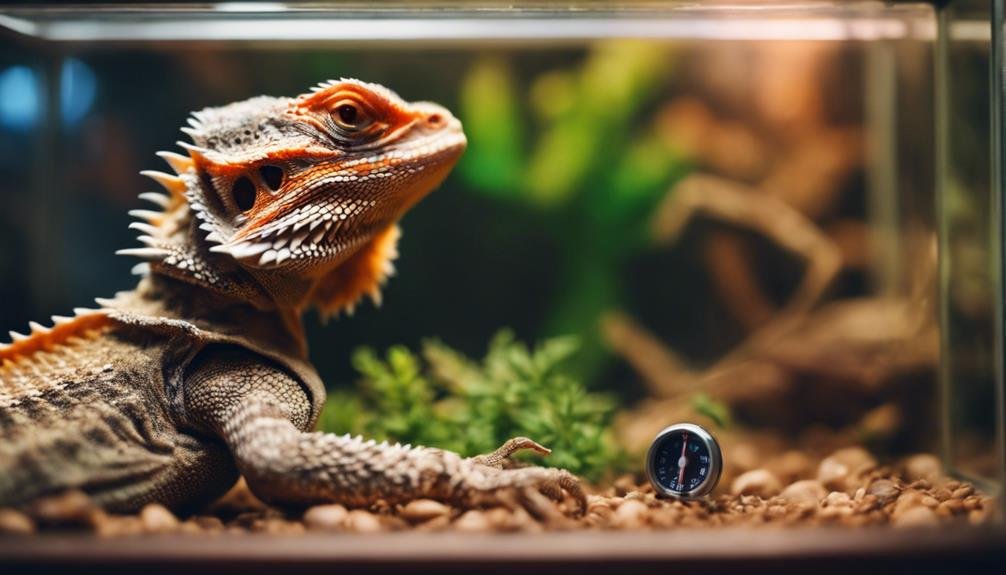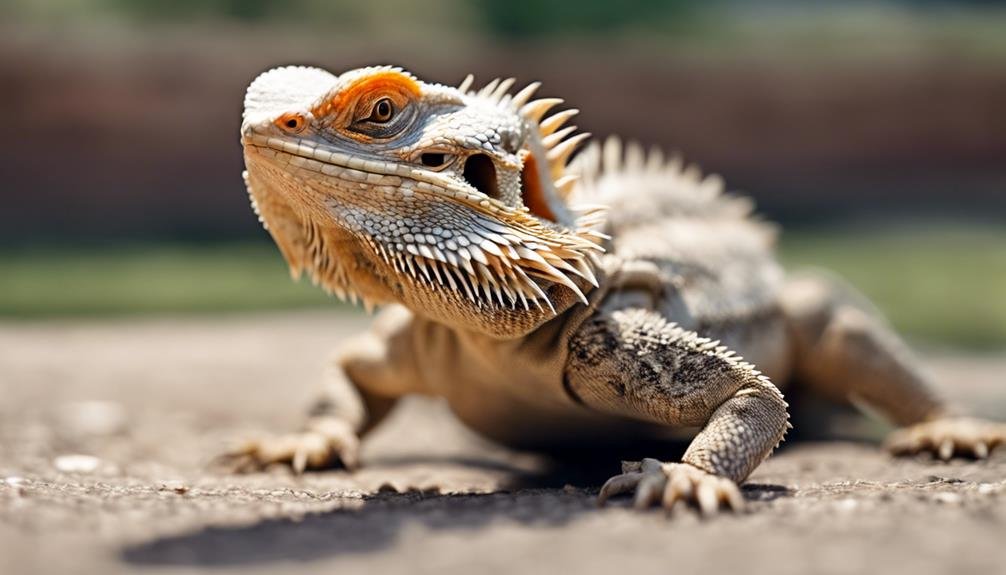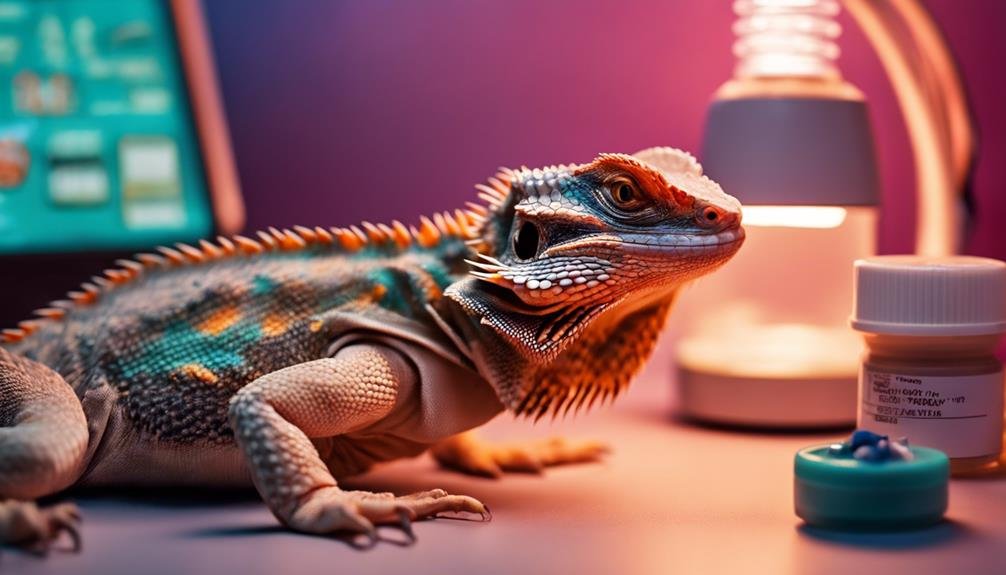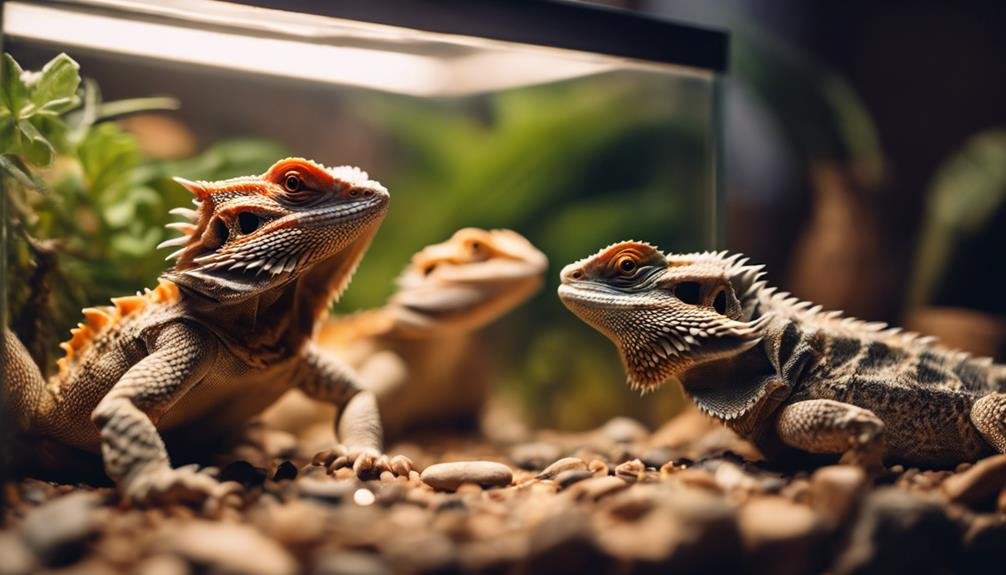If you've noticed your bearded dragon flipping on its back, you're likely concerned and searching for answers. This behavior can be alarming and might signal health or environmental issues that shouldn't be ignored. From metabolic bone disease to inner ear infections, the causes are varied and require your attention. You might wonder how to differentiate between a harmless quirk and a symptom of a serious condition. The key lies in observing the frequency and context of these flips. Let's explore what could be causing this unusual behavior and how you can support your pet's health, leaving you equipped to take the next steps.
Key Takeaways
- Flipping may indicate a health issue such as inner ear infections or metabolic bone disease (MBD).
- It can be a response to cold temperatures, as bearded dragons regulate body heat.
- Persistent flipping behavior necessitates a veterinary check for possible neurological problems.
- Ensure a warm environment and adequate UVB exposure to prevent flipping due to discomfort or disease.
- Regular habitat checks and monitoring for signs of distress are crucial for early detection and treatment.
Understanding Metabolic Bone Disease
Metabolic Bone Disease (MBD) is a prevalent issue in bearded dragons, stemming from a lack of calcium. This condition doesn't just come out of nowhere; it's a direct result of calcium deficiency. When your bearded dragon doesn't get enough calcium, its bones weaken. You might notice it having trouble walking or moving properly, which is a clear sign something's off. But it doesn't stop there. If things get worse, your pet could start having muscle tremors or even seizures.
You're probably wondering how to prevent or tackle MBD. The solution involves two key actions: ensuring your bearded dragon gets enough UVB light and calcium supplementation. UVB light plays an important role because it helps your bearded dragon synthesize vitamin D3, which is essential for calcium absorption. Without adequate UVB exposure, all the calcium in the world won't do much good because your pet's body can't process it properly.
Inner Ear Infection Symptoms
If your bearded dragon's exhibiting symptoms like flipping onto its back, it might be dealing with an inner ear infection. This condition can be concerning, but recognizing the symptoms early can help you seek the right treatment quickly. Besides the distressing sight of your pet flipping onto its back or side and wriggling, there are other tell-tale signs you should be aware of.
- Open mouth breathing: a sign of distress that can indicate your bearded dragon is struggling to breathe normally due to discomfort or imbalance caused by the infection.
- Head shaking and coughing: These behaviors suggest your pet is trying to alleviate discomfort or dislodge something that isn't there, a common reaction to the disorientation caused by an inner ear issue.
- Slow eating: Particularly noticeable in colder weather, this symptom could also signify your bearded dragon isn't feeling well due to an infection.
Treatment typically involves a visit to the vet, who may prescribe medications such as Baytril and recommend liquid calcium supplementation to combat the infection. Recognizing these symptoms early in bearded dragons is important to preventing the condition from worsening and ensuring a swift recovery.
Impact of Cold Weather


When the temperature drops, your bearded dragon might face challenges regulating its body heat, leading to potential flipping. Vital cold weather adaptations are essential for their health, as they struggle with calcium absorption and muscle coordination in lower temperatures.
Ensuring your pet's environment is warm enough can help prevent these issues, keeping them agile and upright.
Temperature Regulation Challenges
Bearded dragons may start flipping on their backs in response to cold weather, highlighting their struggle with temperature regulation challenges. The drop in temperature can greatly slow down their metabolism, making it tough for them to move properly. This unusual behavior often signals their discomfort or the difficulty they're facing in maintaining their body temperature.
- Cold weather impacts their ability to thermoregulate, necessitating a warm basking spot to counteract the effects.
- Slow metabolism in cooler conditions means they can't properly digest food or move as they should.
- Ambient temperatures within their enclosure must be closely monitored to ensure they're suitable for their thermoregulation needs, helping to prevent discomfort and flipping behaviors.
Cold Weather Adaptations
In response to the chill, bearded dragons may resort to flipping onto their backs to soak up warmth from their surroundings, an essential adaptation for surviving colder weather. This flipping behavior is more than just a vital trait; it's a critical method for body temperature regulation.
Cold weather can greatly slow down their metabolism, making it harder for them to stay active and healthy. To combat this, introducing additional heat sources, such as basking lights, becomes indispensable. These lights not only prevent the need for flipping but also guarantee your scaly friend remains warm and energized.
Furthermore, diligent temperature monitoring in their enclosure is crucial during the colder seasons to maintain an ideal environment. By understanding these adaptations, you're better equipped to support your bearded dragon through the cold.
Calcium Deficiency Concerns
If you've noticed your bearded dragon flipping on its back, it's time to contemplate calcium deficiency as a potential culprit.
You'll need to make dietary adjustments, such as adding plain calcium powder to their worms and ensuring they've access to adequate UVB lighting.
Preventing future issues involves recognizing the signs early and responding quickly to keep your pet healthy and happy.
Identifying Calcium Deficiency
You may notice your bearded dragon showing signs of weakness, falling, or even experiencing seizures, which can indicate a calcium deficiency. This worrying condition stems from various factors, importantly including inadequate exposure to UVB rays and insufficient dietary calcium. Addressing these key causes is essential for your pet's health and well-being.
- Insufficient UVB Exposure: Without proper UVB lighting, like the Reptisun 10.0, your bearded dragon can't metabolize calcium effectively.
- Lack of Dietary Calcium: Not supplementing your bearded dragon's diet with plain calcium powder on worms can lead to a deficiency.
- Symptomatic Behaviors: Weakness, shakiness, and seizures are direct indicators of calcium deficiency, signaling the need for immediate intervention.
Dietary Adjustments Needed
To effectively combat your bearded dragon's calcium deficiency, adjusting its diet is an essential step. Insufficient UVB rays can exacerbate calcium deficiency, making it important to provide a reliable UVB light source like Reptisun 10.0.
Alongside, dietary adjustments and supplementation are key. Sprinkling plain calcium powder on worms not only addresses this issue but also prevents further health issues linked to calcium deficiency in bearded dragons. Additionally, warm baths with added calcium powder can enhance absorption, offering a creative yet effective method to boost your pet's calcium intake.
Preventing Future Issues
Having discussed dietary adjustments, let's now focus on strategies to prevent future issues related to calcium deficiency in your bearded dragon.
Prevention is key, and there are straightforward steps you can take to safeguard your pet against the risks of calcium deficiency. Here's how:
- Ensure adequate UVB exposure: Install a UVB light source like Reptisun 10.0 in your bearded dragon's habitat to support proper calcium metabolism.
- Supplement with calcium: Regularly dust your bearded dragon's food with plain calcium powder to address dietary gaps.
- Incorporate warm baths: Offer your bearded dragon warm baths with a sprinkle of calcium powder to promote absorption through their skin.
The Role of Brumation
As winter approaches, it's important to understand how brumation impacts your bearded dragon's behavior and metabolism. Brumation, a form of dormancy akin to hibernation observed in reptiles, notably affects bearded dragons by slowing their metabolic rate to a great extent. This natural process is essential for conserving energy during colder months when food might be less accessible.
During this period, you'll notice a marked decrease in your bearded dragon's activity levels. They may become less interested in their surroundings, eat less frequently, and spend more time sleeping. It's a stark contrast to their usual behavior, but it's a normal, important process that helps them cope with the changing seasons.
Monitoring your bearded dragon's health becomes even more crucial during brumation. Despite their reduced activity and appetite, it's important to ensure they remain healthy throughout this dormancy period. Keep an eye out for any signs of distress or illness, and maintain a comfortable and stable environment to support their brumation.
Understanding brumation and its effects on your bearded dragon's metabolic rate and activity levels is key to ensuring their well-being. Don't hesitate to consult with a reptile veterinarian if you have concerns about your pet's health during this time.
Common Signs of Distress


Bearded dragons often display flipping onto their backs as a distressing sign of underlying health issues that require immediate attention. If you're noticing this behavior in your bearded dragon, it's important to understand that it could be signaling something far more serious than mere clumsiness. Recognizing the common signs of distress can help you take prompt action to address potential health complications.
Some of the distress signs to look out for include:
- Persistent flipping behavior, which might indicate conditions such as metabolic bone disease or calcium deficiency, both of which require urgent veterinary advice.
- Reluctance or inability to right themselves after flipping, suggesting possible neurological issues or severe stress that can exacerbate health problems.
- Visible signs of physical distress, including lethargy, lack of appetite, or unusual posture, which can accompany the flipping behavior, pointing to a need for immediate medical attention.
Understanding these signs is the first step in preventing serious health complications. Don't ignore flipping behavior as a quirky trait; it's a clear call for help. Seeking veterinary advice is essential to determine the underlying cause and make sure your bearded dragon receives the proper care.
Veterinary Diagnosis Methods
Understanding the common signs of distress in your bearded dragon, you'll next want to explore the methods vets use to diagnose these issues accurately. Veterinary diagnosis begins with thorough physical exams, where vets check for any visible signs of illness or injury. They'll look at your pet's skin, eyes, mouth, and posture, searching for clues that could explain why they're flipping on their back.
Blood tests are another vital tool in the diagnosis process. These tests can reveal underlying health conditions, such as infections or organ malfunctions, that aren't immediately apparent. Similarly, fecal exams help vets detect parasites or digestive issues that could be causing discomfort or abnormal behaviors in your bearded dragon.
For more detailed analysis, X-rays and ultrasounds are invaluable. These imaging techniques allow vets to see inside your bearded dragon, identifying impactions, organ issues, or other internal problems that could lead to flipping behavior. Additionally, Atadenovirus testing is essential for ruling out viral infections, a common concern for these reptiles.
Lastly, neurological exams may be performed to assess brain function and rule out neurological issues, ensuring a thorough veterinary diagnosis. This close attention to detail in the diagnosis process is critical for understanding and addressing your bearded dragon's health needs accurately.
Treatment Options Available


Once your vet has pinpointed the cause of your bearded dragon's flipping behavior, they'll recommend specific treatments to address the issue. These treatment options are tailored to tackle the root cause, whether it's an infection, metabolic bone disease (MBD), or another health concern. Implementing these treatments effectively is key to seeing your bearded dragon thrive again.
- Medications: Depending on the diagnosis, your vet might prescribe medications like Baytril for infections or liquid calcium supplements if the flipping is due to calcium deficiency or MBD. These medications are vital in stabilizing your pet's condition and should be administered as instructed.
- Monitoring: After starting treatment, close monitoring of your bearded dragon's behavior is essential. You'll need to watch for signs of improvement or further distress, which includes tracking any changes in flipping behavior, slow eating, or other symptoms previously observed.
- Diet and Environment Adjustments: Alongside medical treatments, your vet may suggest changes in diet or environmental conditions to support recovery. This could involve increasing calcium-rich foods or adjusting the habitat's temperature to ensure your bearded dragon is comfortable and can metabolize nutrients more effectively.
Implementing these treatment options with care and consistency will help your bearded dragon recover from flipping behavior, ensuring a healthier and happier pet.
Preventative Care Tips
To keep your bearded dragon healthy and prevent it from flipping onto its back, it's essential to maintain the tank at the ideal temperature. Regular checks of their habitat guarantee everything's in order, from cleanliness to the setup that promotes natural behaviors.
Additionally, a balanced diet plays a significant role in their overall well-being, reducing the chances of flipping caused by nutritional deficiencies.
Optimal Tank Temperature
Why is maintaining a basking spot temperature of 100-105°F critical for your bearded dragon's habitat? It's crucial for ideal tank temperature, which plays a pivotal role in ensuring your pet's health and well-being. Proper temperature regulation prevents stress and health problems, directly influencing your bearded dragon's behavior.
- Utilize digital thermometers to keep a close eye on the tank temperature, ensuring it stays within the perfect range.
- Temperature fluctuations can cause stress, leading to unusual behaviors such as flipping onto their back.
- Maintaining the right basking spot temperature supports your bearded dragon's natural processes, including digestion and activity levels.
Regular Habitat Checks
After guaranteeing your bearded dragon's tank maintains the ideal temperature, it's important to regularly inspect the habitat for any issues that could harm your pet. Regular habitat checks help prevent flipping behavior by identifying and mitigating potential hazards.
To avoid impaction risks, inspect the substrate, opting for solid options like reptile carpet or ceramic tile rather than loose substrates like sand. Make sure climbing accessories and hides are securely fastened to prevent falls that might cause your bearded dragon to flip.
The right tank sizes and proper lighting are essential for creating a safe environment. Additionally, monitor the cleanliness and temperature levels of the enclosure to support your dragon's well-being and further prevent flipping behavior.
Balanced Diet Importance
Maintaining your bearded dragon's enjoyment of a balanced diet is crucial to preventing health issues, including the important behavior of flipping onto their back. A proper mix of nutrition is crucial for their overall well-being, offering a variety of food items ensures they receive all the necessary vitamins and minerals.
- Variety of live prey: Provides essential proteins and simulates natural hunting behaviors.
- Greens and veggies: Offer a range of vitamins and minerals crucial for health.
- Calcium supplementation: Prevents metabolic bone disease by supporting bone health.
Providing your bearded dragon with these dietary elements helps reduce the risk of behavioral issues, supports vitality, and keeps them happily exploring their environment rather than struggling on their back.
Monitoring Your Bearded Dragon
To safeguard your bearded dragon's health, it's vital to observe them closely for any instances of flipping onto their back. This flipping behavior can be alarming and might indicate underlying health or environmental issues. If you notice your bearded dragon displaying this unusual behavior, it's important to monitor closely and note any frequency or patterns that emerge. This can help you identify potential triggers or health concerns that need addressing.
Pay close attention to environmental factors such as temperature, lighting, and the substrate in your dragon's habitat. These elements play a significant role in their well-being and could contribute to their discomfort or stress, leading to flipping. Adjustments to husbandry practices might be necessary based on what you observe. Regularly assess your bearded dragon for any signs of distress, including but not limited to flipping.
If the flipping persists or is accompanied by other concerning symptoms, don't hesitate to consult a reptile vet. Professional advice can be invaluable in diagnosing and treating any health issues your bearded dragon might be facing. By taking these proactive steps, you'll be better equipped to guarantee the health and happiness of your bearded dragon.
Is a Bearded Dragon Flipping On Its Back Related to Not Eating and Turning Black?
Yes, a bearded dragon flipping on its back may indicate not eating and turning black, signifying potential health concerns. It’s important to monitor their behavior and implement bearded dragon health tips such as proper diet and environmental conditions to ensure their well-being. Regular vet check-ups are also recommended for their overall health.
Frequently Asked Questions
Is It Normal for Bearded Dragons to Lay on Their Backs?
No, it's not normal for bearded dragons to lay on their backs. This behavior could signal heat stress, an improper diet, or issues during the shedding process.
Your dragon's habitat layout, age-related behavior, basking habits, and water intake play vital roles in their well-being.
If you notice them flipping over, it's a red flag that something's off with their health or environment.
Always address these signs promptly to keep your dragon healthy.
What Causes Paralysis in Bearded Dragons?
To guarantee the well-being of your bearded dragon, you must promptly address paralysis caused by various factors. Metabolic bone disease resulting from a vitamin deficiency, particularly calcium, is a common culprit. Inadequate lighting, impacting their UVB exposure, can result in weakened bones.
Tail rot, spinal injuries, infectious diseases, and dehydration symptoms also play a role in their paralysis. Quick action is crucial in tackling these issues to prevent further health complications and safeguard your bearded dragon's health.
How Do I Know if My Bearded Dragon Is Stressed?
If you're wondering whether your bearded dragon is stressed, look for signs like dark spots, loss of appetite, or aggressive behavior. They may also hide more often, surf the glass of their tank, show erratic movements, or have shallow breathing. These symptoms suggest your pet's not feeling secure.
It's important to address these issues by checking their environment, diet, and handling to make sure they're comfortable and stress-free.
Why Is My Bearded Dragon Acting Weird All of a Sudden?
If your bearded dragon's acting weird suddenly, it could be due to various reasons. Diet changes, temperature fluctuations, or even the shedding process might be stressing them out.
A new environment can also affect their activity level. Don't overlook possible health issues; these can stem from improper lighting setup.
It's important to monitor their conditions closely and adjust as needed to make sure they're comfortable and healthy in their habitat.
Conclusion
In summary, if your bearded dragon's flipping onto its back, it's important to take action. This behavior could signal anything from metabolic bone disease to an inner ear infection. Don't let cold weather or calcium deficiency go unchecked.
Consider brumation's role, and always seek a vet's diagnosis. Treatment options vary, but with preventative care and regular monitoring, you can guarantee your bearded dragon stays healthy and happy.
Remember, understanding and quick response are key to your pet's well-being.



[…] pinworms in bearded dragons can lead to the bearded dragon flipping behavior. When a bearded dragon is infected with pinworms, it can experience discomfort and irritability, […]